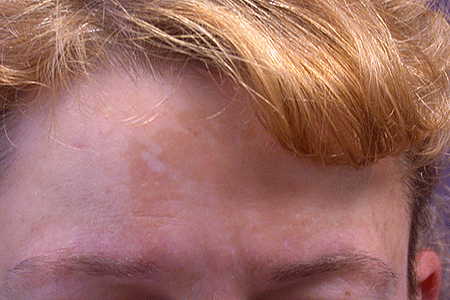Melasma: Signs and symptoms
Where does melasma develop on the body?
Melasma primarily develops on the face, usually on one or more of the following areas:
Cheeks
Chin
Forehead
Nose
Above the upper lip
Occasionally, people develop melasma on their jawline, neck, arms, or elsewhere.
Wherever melasma appears, it causes blotchy patches and spots that can look like freckles. The color varies with a person’s skin tone and the severity of the melasma. In general, melasma is slightly darker than your natural skin color. Most people see various shades of brown. Melasma can look bluish gray in people with darker skin tones.
What are the signs and symptoms of melasma?
The following pictures show what melasma can look like.
Melasma causes patches and spots that are darker than your natural skin color
This woman has melasma on her cheek, chin, above her upper lip, and next to her ear.

Melasma develops on both sides of the face
If you have melasma on your cheeks, you’ll see patches or spots on both cheeks, as shown here. This woman also has melasma on her nose, chin, and above her upper lip.

Melasma can cover a large area
The unevenly shaped patches of melasma can join together, creating one or more large areas of melasma.

Melasma can be more noticeable in one area than another
This woman’s melasma is most noticeable along her jawline. When melasma appears along the jawline, it may be a sign that the skin has been badly damaged by the sun’s rays.

Melasma can appear on the sides of the face
You may see patches like those shown here on the sides of this woman’s face, chin, and above her eyes.

People with a light skin tone can develop melasma
The light brown patch in the center of this person’s forehead is melasma.

Melasma becomes more noticeable when you spend time in the sun
While less common, melasma can develop on the arms, as shown here. Regardless of where melasma appears on your skin, it tends to become more noticeable when you spend time in the sun. Protecting your skin from the sun can help fade dark patches and spots.

Men develop melasma
While melasma primarily affects women, some men develop melasma. This man has melasma in common places like his cheeks, chin, forehead, and above his upper lip.

Melasma isn’t painful or itchy
While this skin condition can be noticeable, you won’t feel anything on your skin. Melasma won’t make your skin itch or cause pain.
While your skin doesn’t feel different, melasma can take a toll on your emotions. Having melasma makes some people feel self-conscious. Studies show melasma can lower self-esteem because it affects your appearance.
If you dislike the way melasma looks, treatment can help. Any treatment plan for melasma will include sun protection. That’s because the sun’s rays play a role in causing melasma.
To see what else may play a role in causing these patches and spots, go to Melasma: Causes.
Images
Images 1, 3, 4, 5, 8: Used with permission of the Journal of the American Academy of Dermatology:
J Am Acad Dermatol 2011;65:689-97
J Am Acad Dermatol 2018;78:363-9
J Am Acad Dermatol 2011;65:689-97
J Am Acad Dermatol 1998;39:S98-103
J Am Acad Dermatol 2016;75:385-92
Images 2, 6, 7: Used with permission of DermNet NZ.
References
Chaowattanapanit S, Silpa-Archa N, et al. “Postinflammatory hyperpigmentation: A comprehensive overview: Treatment options and prevention.” J Am Acad Dermatol. 2017 Oct;77:607-21.
Jang YH, Sim JH, et al. “The histopathological characteristics of male melasma: Comparison with female melasma and lentigo. J Am Acad Dermatol. 2012;66(4):642-9.
Ogbechie-Godec OA, Elbuluk N. “Melasma: An up-to-date comprehensive review.” Dermatol Ther (Heidelb). 2017;7(3):305-18.
Pandya AG, Rivas S, “Melasma.” In: Taylor and Kelly’s Dermatology for Skin of Color. (second edition). McGraw Hill, USA, 2016:356-9.
Sarkar R, Ailawadi P, et al. “Melasma in men: A review of clinical, etiological, and management issues.” J Clin Aesthet Dermatol. 2018;11(2):53-9.
Written by:
Paula Ludmann, MS
Reviewed by:
Arturo Dominquez, MD, FAAD
Ivy Lee, MD, FAAD
Last updated: 2/15/22
 Atopic dermatitis: More FDA-approved treatments
Atopic dermatitis: More FDA-approved treatments
 Biosimilars: 14 FAQs
Biosimilars: 14 FAQs
 How to trim your nails
How to trim your nails
 Relieve uncontrollably itchy skin
Relieve uncontrollably itchy skin
 Fade dark spots
Fade dark spots
 Untreatable razor bumps or acne?
Untreatable razor bumps or acne?
 Tattoo removal
Tattoo removal
 Scar treatment
Scar treatment
 Free materials to help raise skin cancer awareness
Free materials to help raise skin cancer awareness
 Dermatologist-approved lesson plans, activities you can use
Dermatologist-approved lesson plans, activities you can use
 Find a Dermatologist
Find a Dermatologist
 What is a dermatologist?
What is a dermatologist?